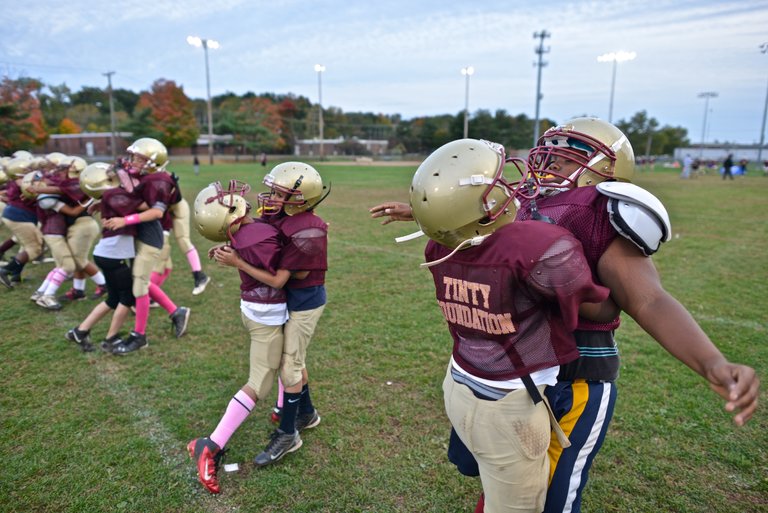N.F.L.-Backed Youth Program Says It Reduced Concussions. The Data Disagrees – In a NY TIMES article recently: As increasing numbers of parents keep their children from playing tackle football for safety reasons, the National Football League and other groups have sought to reassure them that the game is becoming less dangerous.
No initiative has received more backing and attention than Heads Up Football, a series of in-person and online courses for coaches to learn better safety procedures and proper tackling drills. The N.F.L. funds and heavily promotes the program. The league and U.S.A. Football, youth football’s governing body, which oversees the program, have sold Heads Up Football to thousands of leagues and parents as having been proved effective — telling them that an independent study showed the program reducing injuries by 76 percent and concussions by about 30 percent.
That study, published in July 2015, showed no such thing, a review by The New York Times has found. The research and interviews with people involved with it indicate, rather, that Heads Up Football showed no demonstrable effect on concussions during the study, and significantly less effect on injuries over all, than U.S.A. Football and the league have claimed in settings ranging from online materials to congressional testimony.
As the 2016 youth football season dawns, the revelation will most likely fuel skeptics of football’s claims of reform, and discourage parents who want solid information about the sport’s risks for their children.
“Everybody who is involved in trying to improve the safety of youth sports, when parents such as myself are so desperate to have effective solutions, has the responsibility to make sure that any information that they are putting out to the public is accurate, is comprehensive, and is based on legitimate science,” said Elliot F. Kaye, the chairman of the United States Consumer Product Safety Commission, who has worked with U.S.A. Football and the N.F.L. on improving helmet safety. “It does not appear that this met that standard.”
“U.S.A. Football erred in not conducting a more thorough review with Datalys to ensure that our data was up to date,” Scott Hallenbeck, the executive director of U.S.A. Football, said in an email to The Times. “We regret that error.” He added that the material would be removed from the organization’s print and online materials, and that “our partners and constituents” would be notified of the errors.
Brian McCarthy, an N.F.L. spokesman, said that the league would also include updated information from now on.
Both U.S.A. Football and the league said that the questionable data and conclusions were actually preliminary results provided by Datalys five months before the study was published. The lead researchers for Datalys, Thomas Dompier and Zachary Kerr, confirmed in interviews that, despite knowing that the final paper contradicted their preliminary claims, they did not inform U.S.A. Football of this until last month, one day after speaking with The Times. Mr. Dompier, the president of Datalys, said in an interview: “We’re the ones that put out the numbers. We’re the ones that kind of blew it.”
In an email, Mr. Kerr said that the company had released the early data because, “The results were so compelling, we felt morally obligated to make the youth football community aware of the results.”
Conflicting Data
The N.F.L. and its players’ union formed U.S.A. Football in 2002 to oversee the sport and help it grow among children ages 6 to 14. But participation has dropped precipitously in recent years, from 3 million in 2010 to about 2.2 million last fall — a decline generally attributed to concerns about injuries, particularly to the brain.
In 2013, in consultation with the N.F.L., U.S.A. Football started Heads Up Football, whose primary goals were to improve safety and reassure parents. The program requires one “player safety coach” per team to attend a clinic that focuses on concussion recognition and response, blocking and tackling techniques, proper hydration and other safety topics. A team’s other coaches must take online courses in those subjects as well.
In March 2014, the N.F.L. gave U.S.A. Football $45 million, in large part to get more youth leagues to adopt the program.
While U.S.A. Football is said to operate independently from the N.F.L., the league is its primary source of operating funds, and some researchers consider the two almost indistinguishable.
“In my mind, U.S.A. Football and the N.F.L. are one,” said Dawn Comstock, a professor of epidemiology and the primary researcher into high school sports injuries at the Colorado School of Public Health. “If I’m talking with one about something involving youth football safety, my perception is I’m talking to both.”
Dr. Comstock said that in July 2014, Jeff Miller, the N.F.L.’s senior vice president for health and safety policy, and David Krichavsky, then its director of player health and safety, asked her to propose some studies that would, she said, “highlight the potential positive aspects” of youth football’s safety initiatives and provide “a potential positive take-home message for parents.” Dr. Comstock said that she had provided some ideas but that the league did not pursue.
Mr. McCarthy, of the N.F.L., said in an email on Monday, “Our only interest is in research that will help us determine the efficacy of these and other programs and how we can make the game safer.”
Also in 2014, U.S.A. Football asked Datalys, an Indianapolis-based firm that handles all of the N.C.A.A.’s injury research, to monitor injury rates during that fall season among six youth leagues that used Heads Up Football and four leagues that did not, covering more than 2,000 players.
In February 2015, Datalys gave U.S.A. Football the results: Leagues that used Heads Up Football had 76 percent fewer injuries, 34 percent fewer concussions in games and 29 percent fewer concussions in practices.




Leave A Comment